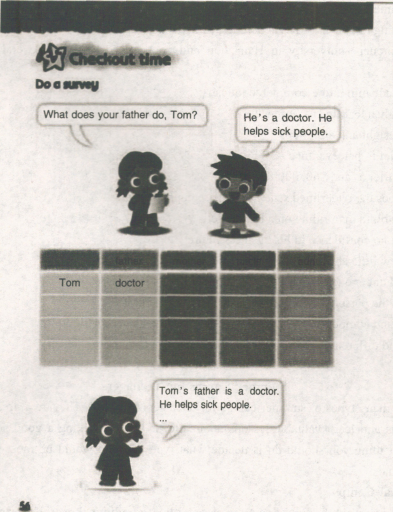
正确答案及解析
正确答案
解析
【参考设计】 Teaching Objectives:
Knowledge objectives:
(1) Students can learn the new words about jobs: teacher, doctor, nurse, singer, TV reporter, actor, actress, etc.
(2) Students can master the sentences: What does he/she do He/She is a(n) ...
Ability objective:
Students can use the new words and sentences to talk about careers in real situation.
Emotional objective:
Students can establish a proper career aspiration.
Teaching Key and Difficult Points:
How to make students master the new words and sentences.
Teaching Procedures:
Step 1 Greetings
T: Hello, boys and girls. How are you today
Ss: I'm fine, thank you. And you
T: I'm very well, thanks.
Step 2 Lead-in
T: Well, boys and girls. Let' s listen to music--My father is a doctor. Can you guess what we will learn today
Step 3 Presentation
(1) T: I teach lessons. I'm a teacher. (Point at herself) (The teacher shows some teachers' photos in turn and asks a question) What does he/she do
(Guide students to answer) Ss: He/She is a teacher.
(2) T: (The teacher shows pictures of doctor and nurse one by one) Is he/she a teacher Ss: No, he/she isn't.
T:.What does he do (Write on the blackboard)
(Guide students to answer) Ss: He's a doctor. She's a nurse.
(Use the same method to teach singer, TV reporter, actor and actress)
(3) The teacher shows word cards and asks students to read after him/her.
Step 4 Practice and Consolidation
(1) Spelling
The teacher divides students into two groups, and gives each person a letter card. T: Teacher!
(Students who have t, e, a, c, h, e, r stand in a line)
(2) Finding your friends
The teacher distributes pieces of paper to each student, which tell "You are a(n) doctor/actor. Your friend is a(n) nurse/actress." Ask students to find their friends by asking "What do you do ""What does your friend do "
(3) Doing a survey
The teacher divides students into six groups, and asks them to do a survey about their family members' jobs.
S1: What does your father/mother/uncle/aunt do
S2: He/She is a(n) ...
你可能感兴趣的试题
“有为才有位,有位更有为”,这一看法给我们的启示是( )
-
- A.实践决定认识,认识对发展具有推动作用
- B.实现人生价值必须先要实现人的自我价值
- C.人生真正价值在于社会价值与自我价值的统一
- D.要发挥主观能动性,要不断积累自我价值
- 查看答案
对立统一规律揭示了事物发展的( )。
-
- A.辩证形式
- B.趋势和道路
- C.不同状态
- D.源泉和动力
- 查看答案
历史唯物主义认为人的价值在于( )
-
- A.个人的自我创造和自我实现
- B.个人的自我选择和自由发展
- C.个人主体性的增强和摆脱社会的制约
- D.个人对社会的贡献和社会对个人的尊重
- 查看答案
矛盾的普遍性与特殊性的关系是( )
-
- A.一般与个别的关系
- B.整体与局部的关系
- C.绝对与相对的关系
- D.可以相互转化的关系
- 查看答案
在认识过程中具有更为重要意义的飞跃是指()
-
- A.从外在形象到内在本质的飞跃
- B.从个性认识到共性认识的飞跃
- C.从肯定阶段到否定阶段的飞跃
- D.从理性认识到实践的飞跃
- 查看答案